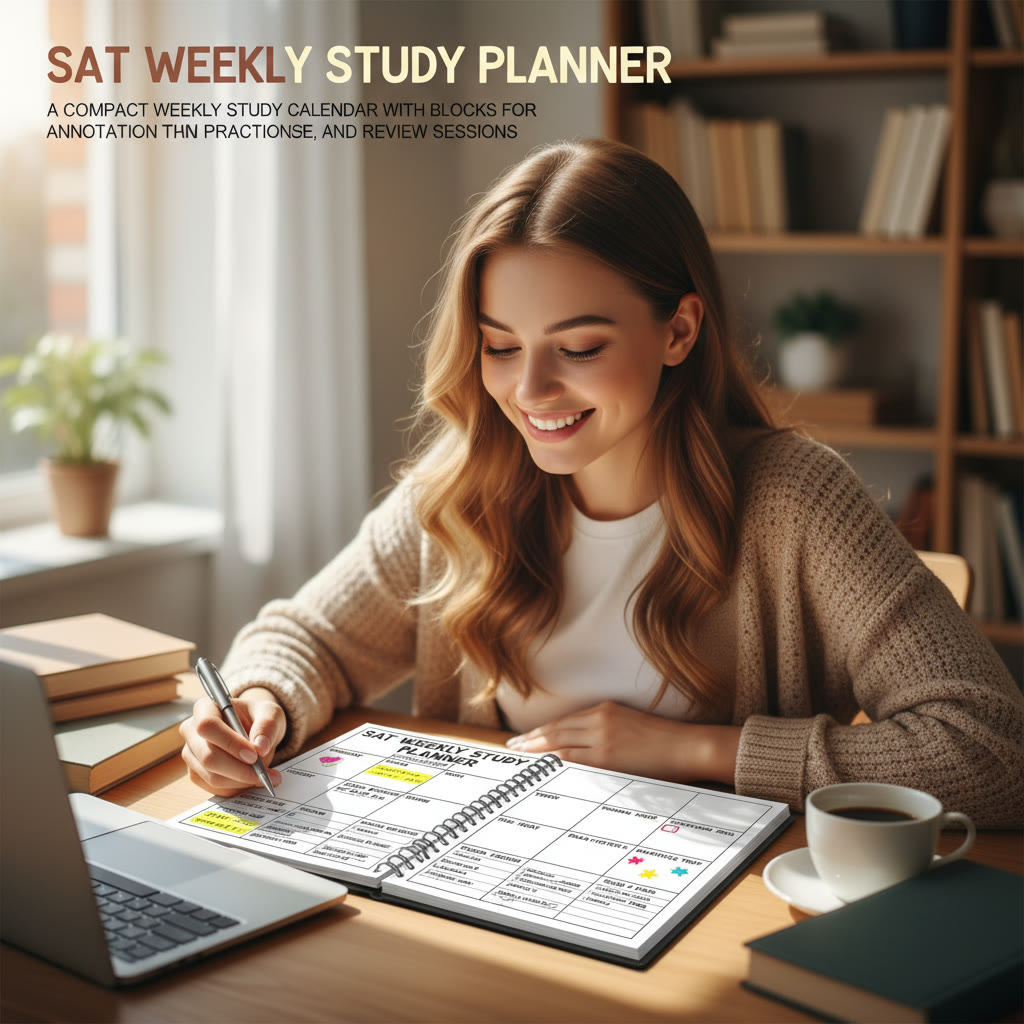Introduction: Read Like a Tester, Not a Passenger
Imagine two students sitting in the same SAT Reading room. One drifts through passages, underlines occasionally, and hopes their intuition matches the right answer. The other steps into each passage like a detective, circles key clues, asks questions, and writes a one-line summary at the top. Which student do you think ends up more confident, faster, and with a higher score?
This is the difference between passive and active reading. Passive reading treats a passage like wallpaper: pretty to glance at, but not something you interact with. Active reading turns each passage into evidence you interrogate, organize, and use. For SAT preparation, that difference is huge — and completely trainable.
What Active Reading Actually Means
Passive vs Active: Simple Definitions
Passive reading is the default: you read the words, you hope they sink in, and you move on. Active reading is intentional: you read with specific goals, mark up the passage with purpose, and translate the text into mental notes that answer likely test questions.
What Active Reading Looks Like in Practice
- Setting an immediate purpose: What is the author arguing? What perspective is presented?
- Annotating deliberately: flagging claims, evidence, tone shifts, and confusing points.
- Summarizing sections in your own words to lock understanding.
- Asking and answering short questions while you read: What is the main point? Why does this detail matter?
Why Active Reading Works: The Cognitive Case
Memory and Attention
Active reading increases attention by making you do something with the information. When you summarize or annotate, you encode the meaning in a different form, which strengthens memory. Passive reading often leads to illusion of fluency: the text felt smooth while reading, but you can’t retrieve the ideas five minutes later.
Higher-Level Thinking and Transfer
The SAT rewards reasoning: moving from details to main ideas, comparing perspectives, and evaluating evidence. Active reading trains those exact skills. When you habitually look for author purpose, evidence, and tone, those cognitive patterns become automatic — and automaticity is your ally under timed conditions.
How Active Reading Maps to SAT Question Types
Main Idea and Purpose
Active reading helps you spot the thesis and the passage’s driving purpose as you go, so these questions become retrieval tasks rather than guessing games. If you jot a one-line summary after each passage, you can answer main idea questions in seconds.
Detail and Evidence-Based Questions
When you underline or tag evidence sentences, you create a quick index. Evidence-based questions on the SAT require you to connect answer choices to passage lines. Having those lines flagged makes the connection immediate and less error-prone.
Inference and Author’s Tone
These questions reward subtle reading. Marking hedges, contrasts, and connotative words forces you to notice the author’s leanings and the passage’s subtext rather than skimming over them.
Paired Passages and Synthesis
Active reading turns each passage into a compact map. When two passages need comparison, you can quickly scan your notes to spot agreements, disagreements, or different uses of evidence. That saves time and reduces confusion.
Concrete Active-Reading Strategies for SAT Success
1. Purpose-Setting: Start with a Question
Before you read, tell yourself the passage’s job. For example: is it arguing a position, describing a process, or narrating an event? This simple step frames your attention and reduces the chance you’ll be distracted by interesting but irrelevant details.
2. Annotate with a System
Random scribbles won’t help under time pressure. Use a consistent shorthand you can read at a glance. Here is a compact system students find reliable:
- Circle or underline the thesis sentence or main claim.
- Bracket strong evidence or examples: [ … ]
- Put a question mark next to confusing or paradoxical statements.
- Use a dash or arrow to note cause-and-effect or contrast.
- Write a 3–6 word summary of each paragraph in the margin.
3. Chunk and Summarize
Break long passages into chunks (paragraphs or groups of paragraphs). After each chunk, summarize the gist in a few words. This practice prevents drift and creates a mini-outline you can scan when answering questions.
4. Predict and Check
At transition points, predict the author’s next move. Is the tone about to shift from descriptive to argumentative? Predicting primes your brain for change and makes contrasts more salient.
5. Train with Purposeful Practice
Do short, focused practice sessions where you only read and annotate, then immediately answer questions. Time your reads, but reserve additional practice for reviewing why wrong answers are tempting. That’s where the learning sticks.
Practical Routines and a Sample Weekly Plan
Active reading becomes a habit when you practice it deliberately. Below is a practical weekly routine that balances skill work and timed practice. Adjust the times to fit your schedule.
| Day | Focus | Activity |
|---|---|---|
| Monday | Annotation Skills | Do 2 passages slowly; annotate fully; write paragraph summaries; review notes |
| Wednesday | Timed Speed | 2 passages under timed conditions; focus on pace; annotate selectively |
| Friday | Question Types | Target specific question bundles: main idea, inference, evidence-based; review mistakes |
| Saturday | Mixed Full Practice | Do a half-section or full practice set; review wrong answers deeply |
| Sunday | Reflection & Vocabulary | Review flashcards for words in context; rewrite tough passage summaries |
Active vs Passive Reading: A Side-by-Side
| Behavior | Passive Reading | Active Reading |
|---|---|---|
| Goal | Finish the words | Extract purpose, evidence, and structure |
| Marking | Occasional underline | Consistent shorthand: thesis, evidence, tone |
| When stuck | Reread slowly | Identify signal words and marshal nearby evidence |
| SAT payoff | Higher risk of misreading questions | Faster, more accurate answers; easier evidence lookup |
Walkthrough: A Mini Passage Example
Let’s practice with a short illustration. Suppose a paragraph begins: —”Early observers praised the river for its bounty, yet recent measurements suggest that fishing yields have declined despite technological improvements.”— Right away, active readers should:
- Mark the contrast words: “yet” and “despite.”
- Ask: What explains the decline? Is the author arguing human impact, policy failure, or natural cycles?
- Note evidence that follows: measurements, dates, or expert quotes.
If a question later asks which statement is best supported by the passage, a passive reader might search text for a sentence that ‘sounds right.’ An active reader will recall the marked contrast and scan for the sentence where the author links the decline to a factor. That retrieval is much faster and more precise.
Common Mistakes When Switching to Active Reading (and How to Avoid Them)
- Over-annotating: writing every thought can slow you down. Keep marks purposeful and brief.
- Annotating without review: If you write notes but never use them to answer questions, the extra work is wasted. Practice retrieving from annotations.
- Thinking active reading is slow: Initially it may add 10-20 seconds per paragraph, but with practice the process speeds up and saves time when answering questions.
Speed vs Comprehension: Finding the Sweet Spot
Students worry that active reading sacrifices speed. The truth is you trade a little upfront time for huge downstream gains. A tiny delay while you annotate is often recovered because you spend less time hunting for evidence or re-reading confusing sections.
Work on two complementary skills: compressing your annotation system into efficient marks, and practicing timed sections so that the annotation becomes a fast reflex. Over weeks, your annotation footprint should shrink while your comprehension remains high.
Building Stamina and Transferable Habits
Genre Exposure
The SAT pulls from various fields: literature, history/social studies, and science. Active reading transfers across genres, but you should practice each. Science passages reward clear cause-and-effect maps; humanities passages reward tone and argument tracing.
Daily Micro-Practices
- Read an editorial or short research summary each day and write a 5-word summary.
- Annotate two paragraphs of anything you read and time the process to build speed.
- Keep a small errors journal: write down the type of question you miss and why.
The Role of Feedback and Personalized Coaching
Active reading becomes powerful when paired with smart feedback. That is where tailored instruction can accelerate progress: targeted corrections on annotation choices, personalized study plans that focus on your weak question types, and one-on-one guidance to refine strategies under timed conditions.
Sparkl’s personalized tutoring can fit naturally into this process by offering 1-on-1 guidance, tailored study plans, expert tutors who point out recurring mistakes, and AI-driven insights that identify tricky question patterns in your practice. These elements help turn good habits into high performance without trial-and-error alone.
Measuring Progress: What to Track
Track both accuracy and process. Accuracy alone hides whether you were lucky or consistent. Process metrics reveal whether active reading is becoming internalized.
- Time per passage: is annotation time decreasing while accuracy holds?
- Question-type accuracy: are inference and evidence questions improving faster than before?
- Mistake categories: careless reading vs misinterpreting tone vs weak vocabulary-in-context.
Real-World Comparison: Students Who Made the Switch
In classrooms and tutoring programs, students who switch from passive to active reading often report similar patterns: a short period of adjustment where they feel slower, followed by steady gains in accuracy and confidence. Many notice they can now eliminate wrong answers faster because they have immediate access to the passage’s structure and evidence.
That confidence matters under SAT pressure. When you approach a question, you want certainty in how the text supports an answer. Active reading gives you the notes you need to be decisive instead of tentative.
Image Ideas


Final Tips: Small Changes, Big Returns
- Start small: add purposeful annotations to one passage a day for two weeks.
- Keep a consistent shorthand so your brain reads your marks without decoding them.
- Review annotations immediately: retrieval practice is where learning happens.
- Use targeted feedback: 1-on-1 coaching or focused review sessions help correct inefficient habits early.
Parting Thought
The SAT isn’t just a reading test; it’s a thinking test. The passages are a platform for evidence-based reasoning, and active reading teaches you to stand on that platform with confidence. If you adopt a clear annotation system, practice deliberately, and use feedback wisely, you won’t just read better — you’ll answer smarter.
If you want to accelerate that process, consider pairing consistent practice with personalized support. Sparkl’s tutors and AI-driven insights can help you refine the exact moves that turn an active reader into a high scorer. Above all, give active reading the runway it needs: practice, reflect, adjust, and watch accuracy rise.
Start today: pick one passage, read it with purpose, mark it up, and write a single-sentence summary. That tiny habit is the first step toward reading with control — and toward a better SAT performance.





















No Comments
Leave a comment Cancel